Subscribe to Our Social Media For Prompt Post
Continuous Wave Laser
CW, an acronym for "Continuous Wave," refers to laser systems capable of providing uninterrupted laser output during operation. Characterized by their ability to emit laser continuously until the operation ceases, CW lasers are distinguished by their lower peak power and higher average power in comparison to other types of lasers.
Wide-ranging Applications
Due to their continuous output feature, CW lasers find extensive use in fields such as metal cutting and welding of copper and aluminum, making them among the most common and widely applied types of lasers. Their ability to deliver steady and consistent energy output renders them invaluable in both precision processing and mass production scenarios.
Process Adjustment Parameters
Adjusting a CW laser for optimal process performance involves focusing on several key parameters, including power waveform, defocus amount, beam spot diameter, and processing speed. Precise tuning of these parameters is critical for achieving the best processing outcomes, ensuring efficiency and quality in laser machining operations.
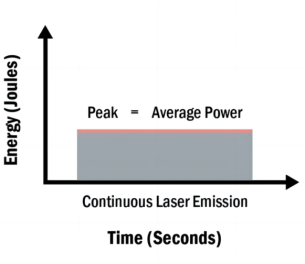
Continuous Laser Energy Diagram
Energy Distribution Characteristics
A notable attribute of CW lasers is their Gaussian energy distribution, where the energy distribution of a laser beam's cross-section diminishes from the center outward in a Gaussian (normal distribution) pattern. This distribution characteristic allows CW lasers to achieve extremely high focusing precision and processing efficiency, especially in applications requiring concentrated energy deployment.
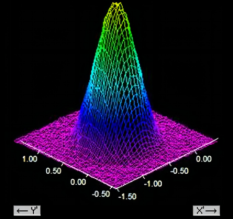
CW Laser Energy Distribution Diagram
Advantages of Continuous Wave (CW) Laser Welding
Microstructural Perspective
Examining the microstructure of metals reveals distinct advantages of Continuous Wave (CW) laser welding over Quasi-Continuous Wave (QCW) pulse welding. QCW pulse welding, constrained by its frequency limit, typically around 500Hz, faces a trade-off between overlap rate and penetration depth. A low overlap rate results in insufficient depth, whereas a high overlap rate restricts welding speed, reducing efficiency. In contrast, CW laser welding, through the selection of appropriate laser core diameters and welding heads, achieves efficient and continuous welding. This method proves particularly reliable in applications requiring high seal integrity.
Thermal Impact Consideration
From the standpoint of thermal impact, QCW pulse laser welding suffers from the issue of overlap, leading to repeated heating of the weld seam. This can introduce inconsistencies between the metal's microstructure and the parent material, including variations in dislocation sizes and cooling rates, thereby increasing the risk of cracking. CW laser welding, on the other hand, avoids this issue by providing a more uniform and continuous heating process.
Ease of Adjustment
In terms of operation and adjustment, QCW laser welding demands meticulous tuning of several parameters, including pulse repetition frequency, peak power, pulse width, duty cycle, and more. CW laser welding simplifies the adjustment process, focusing mainly on the waveform, speed, power, and defocus amount, significantly easing the operational difficulty.
Technological Progress in CW Laser Welding
While QCW laser welding is known for its high peak power and low thermal input, beneficial for welding heat-sensitive components and extremely thin-walled materials, advances in CW laser welding technology, especially for high-power applications (typically above 500 watts) and deep penetration welding based on the keyhole effect, have significantly expanded its application range and efficiency. This type of laser is particularly suited for materials thicker than 1mm, achieving high aspect ratios (over 8:1) despite relatively high heat input.
Quasi-Continuous Wave (QCW) Laser Welding
Focused Energy Distribution
QCW, standing for "Quasi-Continuous Wave," represents a laser technology where the laser emits light in a discontinuous manner, as depicted in figure a. Unlike the uniform energy distribution of single-mode continuous lasers, QCW lasers concentrate their energy more densely. This characteristic grants QCW lasers a superior energy density, translating into stronger penetration capabilities. The resultant metallurgical effect is akin to a "nail" shape with a significant depth-to-width ratio, allowing QCW lasers to excel in applications involving high-reflectance alloys, heat-sensitive materials, and precision micro-welding.
Enhanced Stability and Reduced Plume Interference
One of the pronounced advantages of QCW laser welding is its ability to mitigate the effects of metal plume on the material's absorption rate, leading to a more stable process. During laser-material interaction, intense evaporation can create a mixture of metal vapor and plasma above the melt pool, commonly referred to as a metal plume. This plume can shield the material's surface from the laser, causing unstable power delivery and defects like spatter, explosion points, and pits. However, the intermittent emission of QCW lasers (e.g., a 5ms burst followed by a 10ms pause) ensures that each laser pulse reaches the material's surface unaffected by metal plume, resulting in a notably stable welding process, particularly advantageous for thin-sheet welding.
Stable Melt Pool Dynamics
The dynamics of the melt pool, especially in terms of the forces acting on the keyhole, are crucial in determining the quality of the weld. Continuous lasers, due to their prolonged exposure and larger heat-affected zones, tend to create larger melt pools filled with liquid metal. This can lead to defects associated with large melt pools, such as keyhole collapse. In contrast, the focused energy and shorter interaction time of QCW laser welding concentrate the melt pool around the keyhole, resulting in a more uniform force distribution and a lower incidence of porosity, cracking, and spatter.
Minimized Heat-Affected Zone (HAZ)
Continuous laser welding subjects materials to sustained heat, leading to significant thermal conduction into the material. This can cause undesirable thermal deformation and stress-induced defects in thin materials. QCW lasers, with their intermittent operation, allow materials time to cool, thus minimizing the heat-affected zone and thermal input. This makes QCW laser welding particularly suitable for thin materials and those near heat-sensitive components.
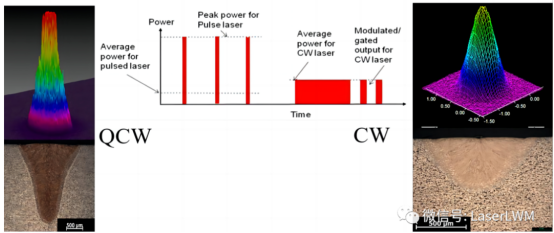
Higher Peak Power
Despite having the same average power as continuous lasers, QCW lasers achieve higher peak powers and energy densities, resulting in deeper penetration and stronger welding capabilities. This advantage is particularly pronounced in the welding of copper and aluminum alloys' thin sheets. In contrast, continuous lasers with the same average power may fail to make a mark on the material's surface due to lower energy density, leading to reflection. High-power continuous lasers, while capable of melting the material, can experience a sharp increase in absorption rate post-melting, causing uncontrollable melt depth and thermal input, which is unsuitable for thin-sheet welding and may result in either no marking or burn-through, failing to meet process requirements.
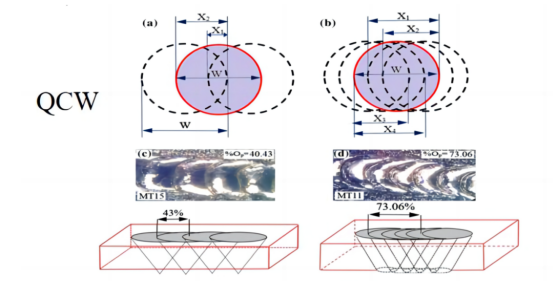
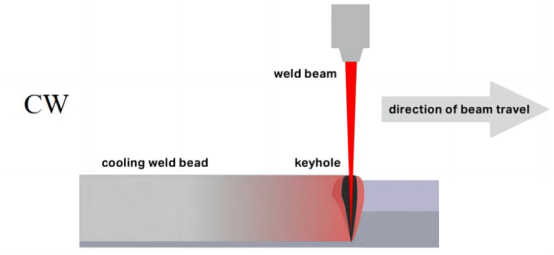
Comparison of welding results between CW and QCW lasers
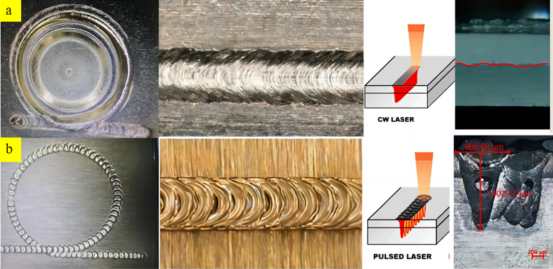
a. Continuous Wave (CW) Laser:
- Appearance of the laser-sealed nail
- Appearance of the straight weld seam
- Schematic diagram of the laser emission
- Longitudinal cross-section
b. Quasi-Continuous Wave (QCW) Laser:
- Appearance of the laser-sealed nail
- Appearance of the straight weld seam
- Schematic diagram of the laser emission
- Longitudinal cross-section
- * Source: Article by Willdong, via WeChat Public Account LaserLWM.
- * Original article link: https://mp.weixin.qq.com/s/8uCC5jARz3dcgP4zusu-FA.
- The content of this article is provided for learning and communication purposes only, and all copyright belongs to the original author. If copyright infringement is involved, please contact to remove.
Post time: Mar-05-2024
